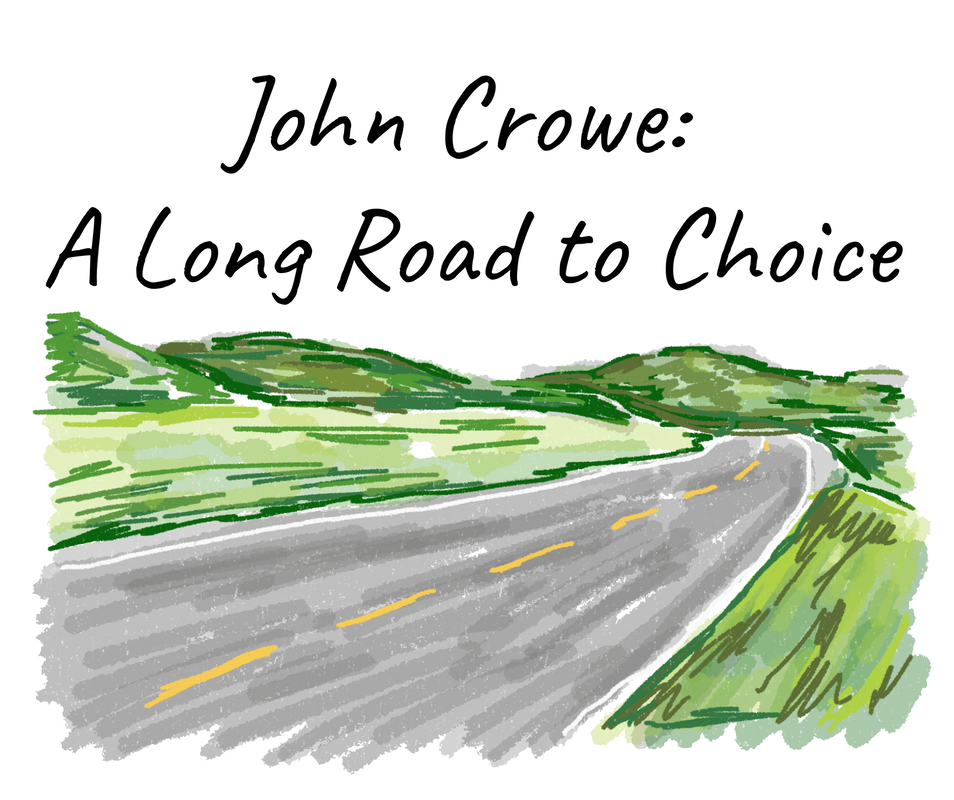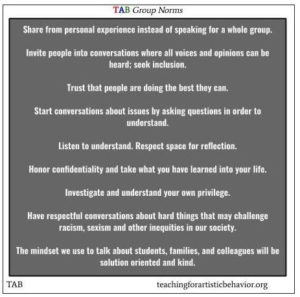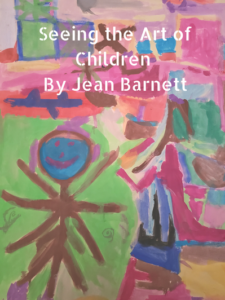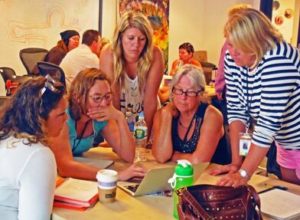
John Crowe: A Long Road to Choice
Burnell Laboratory School Bridgewater, MA
Originally appeared on knowledgeloom.org/tab via the Education Alliance at Brown University.
For art teacher John Crowe, the long road to choice−based art education began with teaching in elementary and high schools, then evolved to a position as professor of art education and hands−on work in schools. It has been an ongoing investigation of how to bring elements of choice to art education.
Crowe was initially trained in the theory and practice of Victor Lowenfeld, who was concerned with the emotional, intellectual, physical, social, and creative growth of children through art experiences led by the teacher. (See Lowenfeld and Brittain’s Creative and Mental Growth, 1967.) In his first teaching experiences, however, Crowe felt “on stage,” conducting Lowenfeld−inspired motivations every 45 minutes for over 2,000 students in seven different elementary schools with no art rooms, no sinks, and no carts. The once−a−month art lessons were exhausting but provided him with enthusiastic applause six times a day, and, he states, “What job offers that?”
At the age of 25, he decided to change the pace and context, and he transferred to the high school level where he taught for 11 years. “The luxury of meeting with high school students every day and working on long−term projects led to a more fulfilling teaching experience involving more individualized instruction,” he says.
In 1989, Crowe became an assistant professor at Bridgewater State College. One component of his job was developing the art education program for 300 elementary students at the Burnell Laboratory School, which had an affiliation with the college. Reentering the classroom as an elementary school teacher, Crowe had a surprising reaction:
“I began by relying on my tried and true Lowenfeldian approach, but it now felt heartbreakingly hollow. I noticed that the results of the lessons were driven by my role as the sole provider of motivation, subject matter, materials, and methods. I felt on stage: My relationship to my students was like a performer to an audience. I really missed the one−on−one dialogues I was able to have with my high school students, and I wondered if I could build those intimate, artist−to−artist relationships with my new elementary school students.”
In an effort to connect more to his students, it occurred to him to survey the fifth and sixth graders’ interests in preparation for conducting a unit on painting. He asked two questions of the 100 students: If you were able to create a painting about anything, what would you be interested in painting? He asked students to ignore what they felt they couldn’t do, maintaining that he would teach them. Sample responses were: something outside, mountains of Vermont, mother and daughter doing something together, a football game, Paradise (Revelation 21: 3,4), a bald eagle flying, things of cheer, a glass castle. If someone were to ask you to paint something, what would be your least favorite thing/subject to paint? Sample responses were: a boring painting, a fishbowl with no fish, falling off a cliff, Hitler, a well textured animal, a dancer, a picture of someone I know, a one−color painting.
He took the surveys home to organize them; it was easier than he anticipated. The student responses fell into the categories of people, landscapes, objects, and imaginative scenarios. He compiled a list of preferences from each of the four classes and gathered books and resources for the chosen subjects. When he met each class at the art room door, he called out the names of students organized by interest category. Each group was assigned to a large table and asked to look at the material piled in the center. Some students figured out that the resources related to their surveyed interests. After a brief introduction to what he had arranged, he stated, “I want you to follow your interests. Use the resources for inspiration if you wish. I will teach you individually and in small groups what you need to know to paint what you want to paint.”
He offered mini−lessons: for example, mixing a variety of skin tones to the figure painting group, the many ways of creating the illusion of distance to the landscape group, the tradition of drawing upon dreams to the imaginative scenarios group. In addition, he honored individual and group requests for instructional topics. Since he provided a wide variety of exemplars, the class had many sophisticated discussions around the definitions of the genres in addition to the ‘how to’ requests. He reflects on the success:
“Teaching became more fulfilling for me, learning more engaging for my students. The resulting artwork was more authentic and varied. My first step toward student choice was modest, yet encouraging. I was off the stage and into the more intimate venues of small groups, organized around their own motivations, not mine.”
The substantive discussions around the landscape, figure, still life, and imagination/dreams genres inspired him to revise his curriculum for fifth− and sixth−grade students. “I was thinking about how we teachers try to accommodate different learning styles and wondered how I could concurrently support a variety of art styles. As a start, I decided to adopt the identification and descriptions in Edmund Burke Feldman’s Varieties of Visual Experience (1972) of four art styles: objective accuracy, formal order, emotion, and fantasy.”
The following year, Crowe offered students a choice of these four styles for every assignment. For example, a figure drawing assignment would outline four distinct challenges, each based on a single art style, from which students could choose. “I was working with many student teachers and interns at the time,” he reflects. “They found this structure to be helpful in designing lesson plans, looking at an assignment in four different ways. The students clearly appreciated the choices and were intrigued by their classmates’ choices −− it was like multiplying the art content by four.” (In retrospect, Crowe comments, “If I were to pick up this curriculum structure again, I would use as the foundation Graeme Chalmers’ roles of artists, outlined in his book Celebrating Pluralism: Art Education and Cultural Diversity −− it would be much more inclusive.”)
Meanwhile, he was teaching grades 1−4 in a more conventional manner. Searching for ways to open up, his thoughts returned to the elementary school teaching of an old friend and colleague, Kathy Douglas. He says, “I remembered the energetic spirit of students working in the many centers in Douglas’s choice−based classroom: The room was alive with purposeful activity. But I knew couldn’t spin all those plates at once, all those 2D and 3D centers, even a clay center with a firing schedule!” Crowe thought hard over the following summer about how to structure a center−based art room that he could handle. He started with what he wished students would do better. “I was struck by how most of my students weren’t inclined to play with materials or ideas. And, at the same time, they weren’t apt to care about any single work beyond the allotted 45 minutes. How could they, within my conventional pedagogical structure?”
As a solution, Crowe developed the themes of PLAY &CARE as the basis of a curriculum framework. Every class brainstormed what ‘play’ and ‘care’ meant to them in terms of art work and shared the results. The sharp focus of these age−appropriate themes helped to clearly communicate the goals of program to the most important group, the students.
He posted the following schedule for all his students in grades 1−6 to see:
Term 1: Drawing PLAY (4 − 5 weeks) & CARE (4 − 5 weeks)
Term 2: Painting PLAY (4 − 5 weeks) & CARE (4 − 5 weeks)
Term 3: 3D PLAY (4 − 5 weeks) & CARE (4 − 5 weeks)
Term 4: Student Choice PLAY (4 − 5 weeks) & CARE (4 − 5 weeks)
Crowe and his college student helpers provided a dozen media and content−area centers designed around the subjects of each term. For example, the drawing centers covered media such as colored pencils, ink and related tools, mechanical drawing instruments, charcoal, and chalk. Centers for content areas included human anatomy and “writing as drawing.” There were fewer 3D centers, but they included found object, woodworking, and clay centers. An age−appropriate library with a reading rug was always accessible.
Working in the centers, students conducted PLAY experiments with media and content. Over time, students assembled their experimental artwork into portfolios that provided the basis for reflecting on their artwork and guiding their learning. Crowe asked students to place stars beside their favorite PLAY experiments and file these in the front of their portfolios. Then he had individual discussions with students about their PLAY experiments. Discussions centered on finding a direction to explore for their CARE works, or longer term projects. “With some classes, who seemed skittish about truly playing, I mandated that they make at least 10 mistakes and number these in their portfolios. It was a revelation to some that their ‘mistakes’ could become some of their favorite PLAY adventures and even lead to a longer term CARE project.”
The one−year PLAY &CARE experiment was a huge success. He explains, “It seemed to strike a perfect balance of structure and freedom both for me and my students. So many of my classroom management problems disappeared when students could pace and direct themselves. Students could hop from one center to another in a single session, or work week after week on a major undertaking. But above all, students were required to find their own paths and delighted in the freedom to pursue them. I delighted in teaching individuals and small groups about topics they were motivated to learn. I was free of a prewritten script.”
Assessment of PLAY &CARE was a challenge, however. Crowe was required to grade each of his 300 students four times a year. The grading system was as follows:
O = Outstanding
S = Satisfactory
To align this grading system to his PLAY &CARE centers−based curriculum, he took a creative approach. “I decided to base a grading system on a version of the old ‘saw’:
A laborer uses his/her hands.
A craftsman uses his/her hands and mind.
An artist uses his/her hands, mind, and heart.
He devised a grading system symbolized by three icons: a small drawing of a pair of hands, a brain, and a heart. The trio of icons were posted in the art room and served as a basis for ongoing assessment discussions. “I talked about behaviors, and I dramatized them to the students’ amusement. If a student came into the art room and simply worked, talked to their neighbors about recess and paid no mind to what they were doing, that behavior earned an N grade; if a student thought out a solution to a problem, that behavior earned an S; if a student was totally involved, concentrating, working, and thinking, that behavior earned an O.”
At the end of the PLAY & CARE phases, each student received a small self−evaluation slip. Students circled the appropriate icon of hands, mind, heart; older students were asked to add written comments. After students filled the evaluations out, they met with Crowe individually to review their PLAY & CARE portfolios. This could take place during class time because the class expectation was clear: to be engaged artists. As Crowe describes the process, “Students were working in the centers, obtaining the materials they needed, and pursuing their own objectives, while I was free to sit and have a private discussion with each and every student for at least a few minutes over two or three sessions. This was truly gratifying and fun!”
Crowe adds, “Another benefit of this transparent grading system was the clarification of the art grading process for parents. My initial presentation of the system to the Parents’ Council was met with enthusiastic support because it helped to demystify grading art. Many parents told me that they had interesting discussions with their children about what the icons of hands, mind, and heart meant. The principal agreed to print the icons on the actual report card −− they were quite a sight in the context of all the other words and codes.”
From developing engaging assessment methods to choice−based centers to flexible curricular frameworks, Crowe has developed art education practices that enable him to interact with students as artists and to communicate to parents and administrators about the richness and value of students’ authentic artistic behavior.



